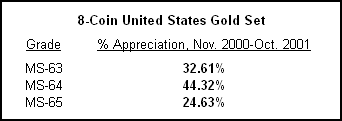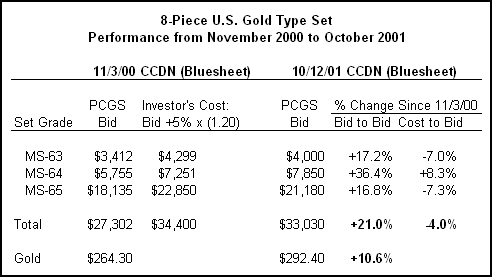| . |
|
The Rosen Numismatic
Advisory The "New
Blanchard" Blasphemy: Maurice Rosen BACK IN THE EARLY 1970s, JAMES U. BLANCHARD, III was a pioneer in the developing hard-money industry. Through his organization, National Committee For Monetary Reform, he championed the American public's right to own gold, which since 1934 was denied to them by the Federal Government. As the decade progressed: since 1/1/75 when, indeed, Americans had that right restored to them, as the inflation disease gripped the country, and as the prices of gold & silver zoomed into orbit, so did the once modest firm and plans of JUB. I knew him well (he died a few years ago). I was his firm's first Director of Numismatics, having created that division within his organization in 1979. Some years later, JUB developed an in-house numismatic division and became a major force in the industry. He was probably best known for his lavish, annual investment conferences which featured as speakers many of the most renown and respected figures in the world of investments. I was proud to have been counted among them during the late 1970s and early 1980s. But until only a few months ago, his organization, which continued after his passing, was best known for its unswerving allegiance to and admiration for gold. Even after the many wildly violent and chaotic markets after the 1980 bust (when gold topped at $887 in January), JUB held fast to his faith and support for every person to maintain a core holding in gold. Investors were encouraged to have larger positions, as his outlook was relentlessly a bullish one. One might fault him for becoming a bit too grandiose, sometimes given to spasms of imprudent hyperbole and commercialism, but no one could fault his affection for what started his whole career - gold. That is not until years after his death when his firm's "benefactors" saw fit to, in so many words, condemn gold, pronouncing it, essentially, as a fraud to its long-held supporters. Often was the time when JUB would recommend exchanging one's gold bullion coins for U.S. $20 Double Eagles. Sure, that was largely a marketing ploy to drum up extra business during the dark days of an inactive gold market and to benefit from much beefier margins selling the $20 gold pieces. But it's the lengths to which the firm has now gone that strikes me as over the top. Gold crashing below $200? Gold no longer an inflation hedge? JUB must be spinning in his grave! A Trap For Whom? At the end of 2001, Blanchard and Company, Inc., through its Blanchard Economic Research Unit division, published a special report, GOLD BULLION: CAUGHT IN A BEAR TRAP. Written by Donald W. Doyle, Jr., Chairman and Chief Executive Officer, Blanchard and Company, Inc., its 53 tightly-spaced pages presents a knock-out punch to its legions of loyal gold supporting clients and other readers. Here's a sampling of its "blasphemous" comments:
Frankly, I was shocked - shocked! - reading this report. Extremely well-written, its arguments appear to be persuasive and, to some degree, convincing. What makes the message even more potent is from whom it is coming: a firm with a 30+ year history of championing for people to own gold, and for the increasing important role that gold should play in world economies. Why, its message is as volcanic a statement as if all the brokerage firms in the country had joined together to renounce the marketing of stock and bond mutual funds that are sold with loads, and to freely admit that no-load funds are the only ones an investor should consider! It is, by far, the most devastating anti-gold investment report I've ever read (albeit 22-years late!). Then I spotted what caused me to exclaim "aha!" Innocently buried in the report (page 9) is this revealing paragraph: "The most commonly traded rare coins have gone up over 60% in the last six months. There was a strong positive correlation between gold and rare coins before the Greenspan era (prior to August 1987), and a negative correlation after Greenspan. Rare coin prices have gone up even as gold prices went down." Accompanying the Bear Trap report was a package of materials. One of them was the newsletter Numismatic World, by Blanchard and Company, Volume 3, Number 2. There's no stated date of publication, but from what I can gather it was around November 2001, about the same time as the Bear Trap report. After ten pages of U.S. gold coin recommendations, and bullish extracts from the Coin Dealer Newsletter (CDN) and the Certified Coin Dealer Newsletter (CCDN) taken from their June 2001 through September 2001 issues, Numismatic World states: "Heading into the active fall coin show circuit, rare coins have turned in remarkable performance since the market began taking off way back in 11/01 (sic). The following table illustrates the great performance of one of the most widely traded areas of the rare coin market, Mint State Gold:
"In an otherwise well-documented report, I find it most interesting that there isn't one citation or footnote given in Bear Trap supporting the hugely spurious claim that, "The most commonly traded rare coins have gone up over 60% in the last six months." Nor is any source given in Numismatic World for the performance statistics of the just-quoted 8-coin United States gold set! Be that as it may, Numismatic World does mention starting and ending dates which I set out to verify. Why was I undergoing the exercise? #1) I doubted
the performance claims, Since no specific pricing reference or its issue dates are given, I turned to the widely-used Certified Coin Dealer Newsletter (Bluesheet). Not knowing which weekly issues of the Bluesheet to use for "November 2000" and "October 2001," I used the ones that produced the lowest starting prices in 11/00 and the highest ending prices in 10/01, thus conceding this advantage. Remember I mentioned profit margins and market spreads? For the comparisons made here, it is totally fallacious and invalid to merely show past performance statistics solely on a bid to bid basis without a reasonable recognition of actual total market prices paid and estimated net proceeds received. I call this "cash in versus cash out." Accordingly, I made two assumptions. One, I assumed that the selling firm's cost was Bluesheet bid +5%. That reflects a reasonable inter-wholesale market buy-sell spread for U.S. gold type coins. Two, I assumed that the selling firm would price the coins to their clients at their cost +20%. The actual investor cost could be higher or lower, but this is a very reasonable estimate (actually, at first I was going to use cost +25%). Thus, if a coin has a bid of $1,000, I assumed the firm's cost was $1,050 (bid + 5%), and an investor would pay $1,260 (cost + 20%). Expressed in my own terms, defined as Net Liquidation Value, the NLV = 79% ($1,000 / $1,260), which assumes an investor would receive net proceeds of the full bid when selling these coins in the wholesale marketplace (another concession).
The performance statistics claimed in Numismatic World do not agree with mine. They claim the MS-63 set appreciated by 32.61%; my analysis shows +17.23%. They claim the MS-64 set appreciated by 44.32%; I show +36.40%. And, for the MS-65 set, they claim +24.63%; I show +16.79%. It could be that they used prices from a source other than the Bluesheet. In my opinion, the use of other price sources is not nearly as reliable and realistic for these coins which trade fairly actively and for which the Bluesheet performs a worthy job of reporting. What's more, my opinion is supported by the wide use of Bluesheet quotes in the marketplace, where it counts. More telling is the firm's failure to include real-world pricing. Claiming that a coin's bid appreciated x% is far from the whole story. Spreads and profit margins must be recognized. When they are, the results can be vastly different, as my figures show. Whereas the total percentage increase for the three graded sets was 21% bid to bid, when my assumptions for the firm's costs and selling prices are recognized, the investor's Net Proceeds reflects a loss of 4%. Moreover, in sharp contrast to the bold claims in the Bear Trap report, coin prices turned in an inferior performance compared to gold. During the same period that these sets lost that 4%, gold rose by 10.6%! One might argue that gold bullion coins carry transaction costs, too. Agreed, but slight. But what about the investor who switched out of his gold bullion coins and into these sets? Now, please permit me to update these performance statistics using the May 31, 2002 Bluesheet as a closing date, instead of the October 12, 2001 edition. Bid for the MS-63 set declined to $3,768 from the $4,000 of 10/01. The MS-64 set fell to $7,130 from $7,850. And, the MS-65 set fell to $20,330 from $21,180. For the three sets, the change from November 2000 to May 2002 is +14.4% (down from +21% ending 10/01). This reflects a loss of 9.2% based on the estimated Investor's Costs! On the other hand, the price of gold is listed at $323.90, a gain of 22.6%! These updated results present an even more dramatic comparison! For, if an investor had heeded the firm's advice in November 2000 - exchanging his gold bullion coins for U.S. gold type coins- his net equity position would be impaired by 26%, despite the increase in the bid-to-bid quotes for the gold coins of 14.4%! Based on Net Liquidation Values, he would suffer an estimated 9.2% loss on his new coins and have given up a 22.6% gain on his gold! Is this the "remarkable performance" claimed by the firm "since the market began taking off" in 11/2000? Bottom-Line: Investing in rare coins and Getting Your Money's Worth is difficult enough without confronting the biased use of misleading statistics and the beguiling spin of seemingly respectable and erudite reports. Frankly, in all my 34 years as a professional numismatist, the knock-out punch delivered by the Bear Trap report appears as convincing and well-researched as any I've seen. And, to be honest, the report may be right! Gold may, indeed, have far more to go on the downside, perhaps below $200 (although I highly doubt it)! I'm not equipped to challenge that here, but I am when I see the use of faulty coin pricing data and spurious, misleading comparisons to justify a dealer's claims. Think what they want you to believe: Gold will sink below $200 while U.S. gold type coins appreciate! Gold will lose over 40% of its current value while the 8-piece type set goes up in price! And, it will do this because of what reason? Some 53 hard-hitting pages are presented to us about why the gold price should fall precipitously, without one convincing word why U.S. gold type coins should appreciate during the same time - including common $20 gold pieces in MS-63, and near-common $20 dates in MS-62! Have things changed much since the shameful days of the Salomon Brothers Study? You be the judge! Maurice Rosen MAURICE ROSEN has been a full-time rare coin dealer, investment advisor and newsletter writer since 1968. The Rosen Numismatic Advisory has received the "Best Newsletter of the Year" award from the prestigious Numismatic Literary Guild an unprecedented 13-times, from 1985-2001. Mr. Rosen's professional memberships include: PNG, ANA, PCGS, NGC, NLG, FUN, LSCC. He is president
of Numismatic Counseling, Inc., ©Copyright 2002 Numismatic Counseling, Inc. All Rights Reserved. _________________ |

